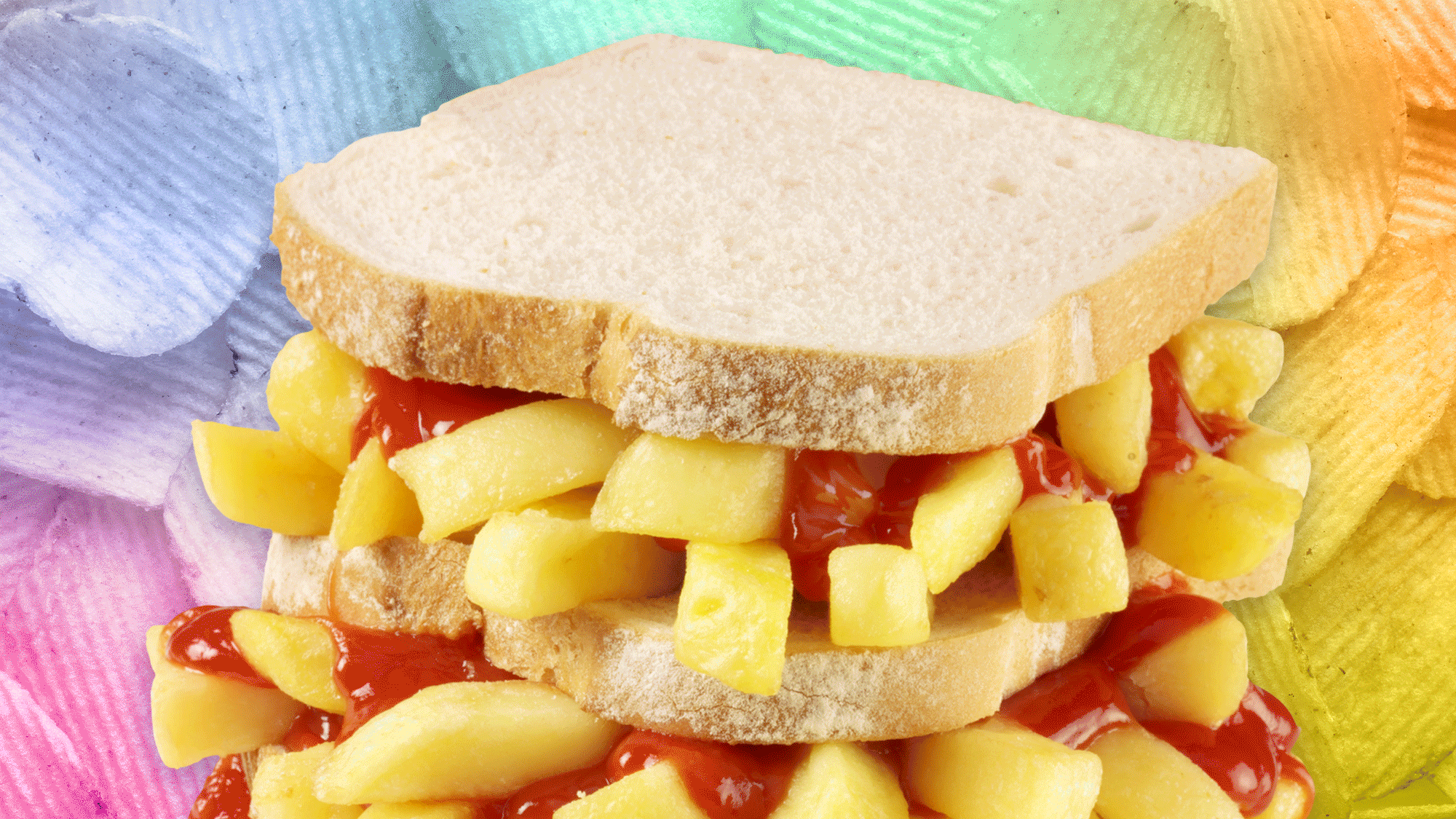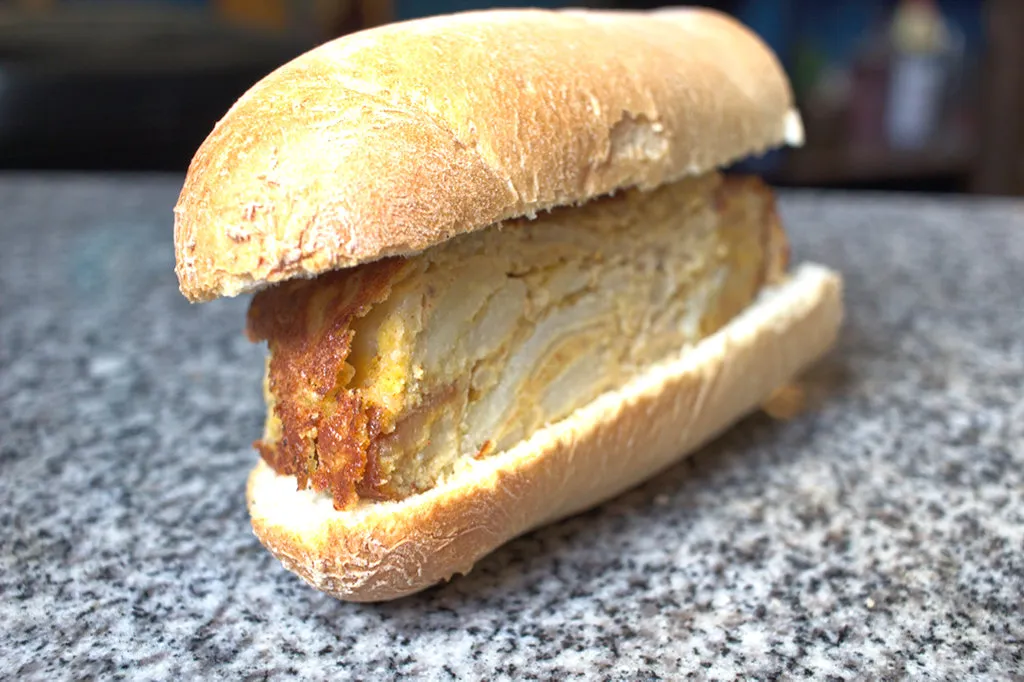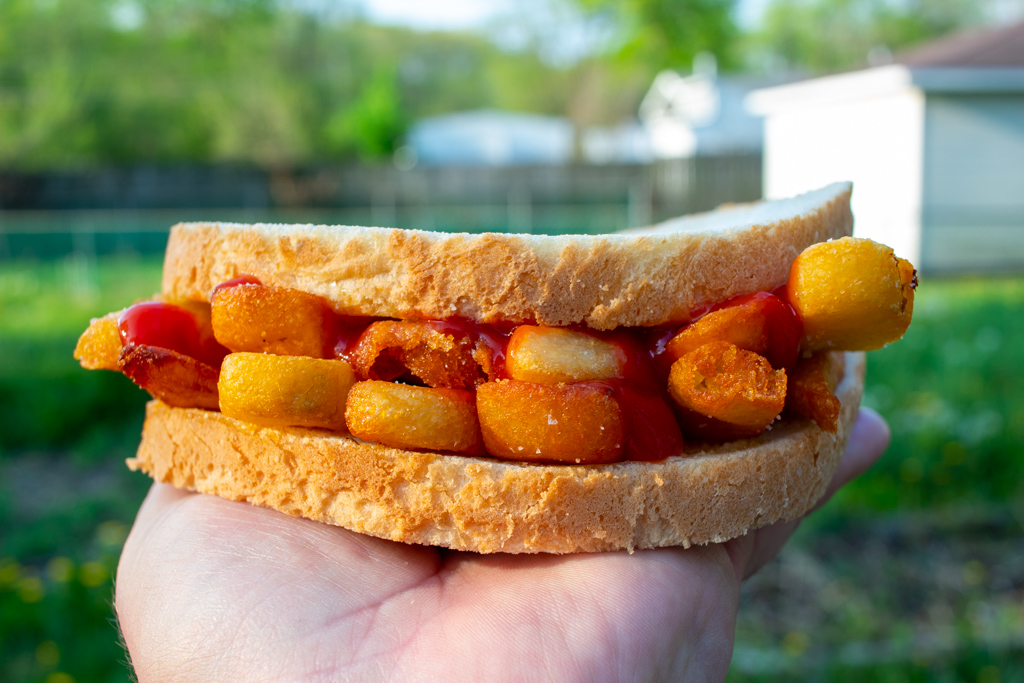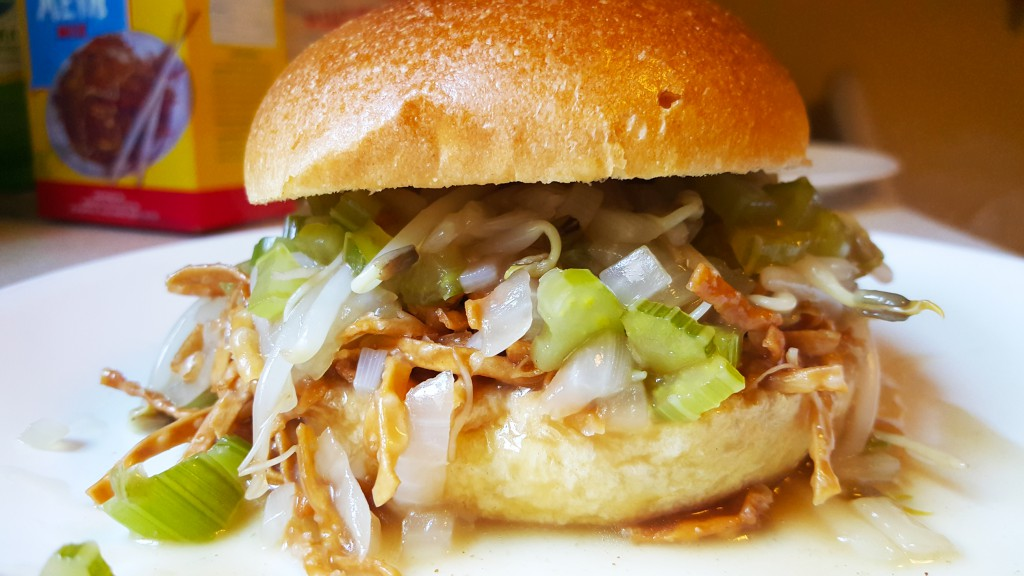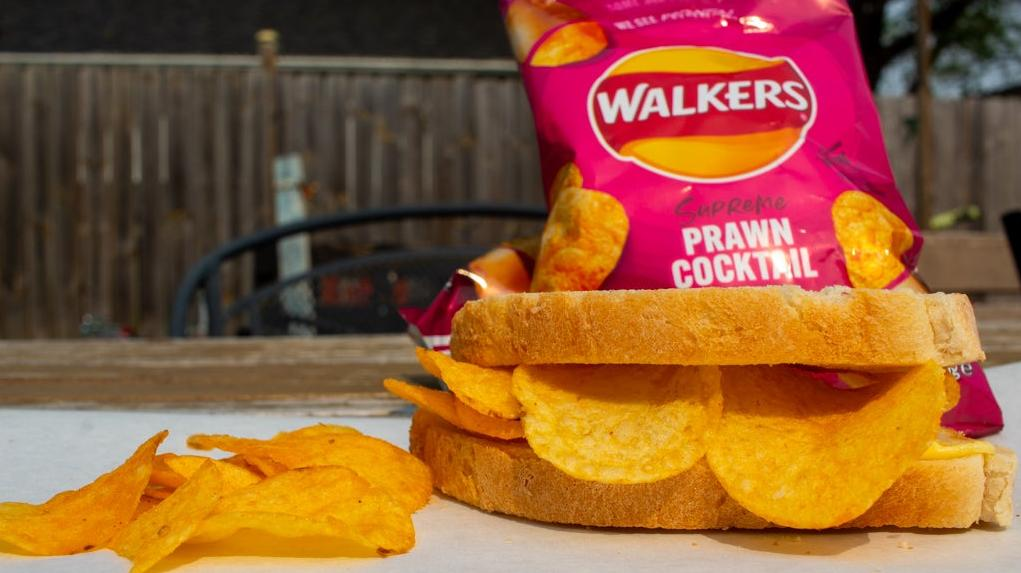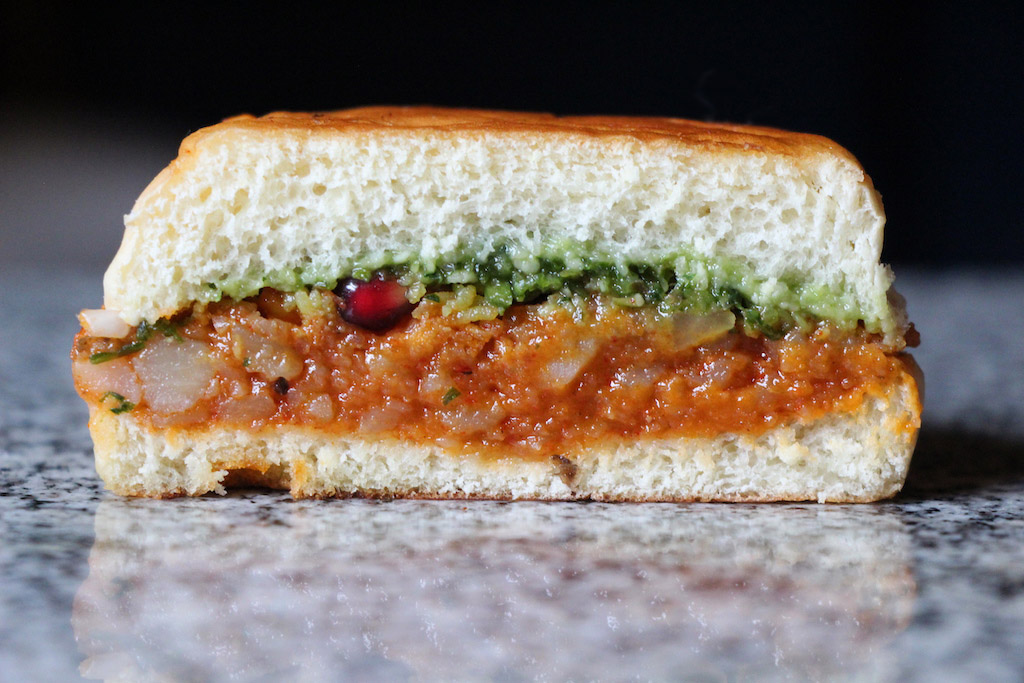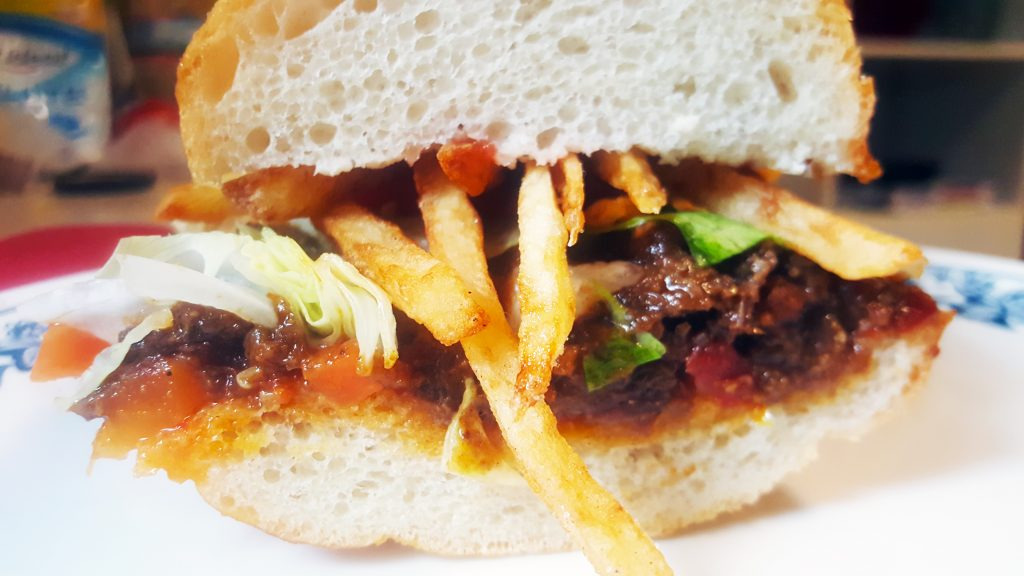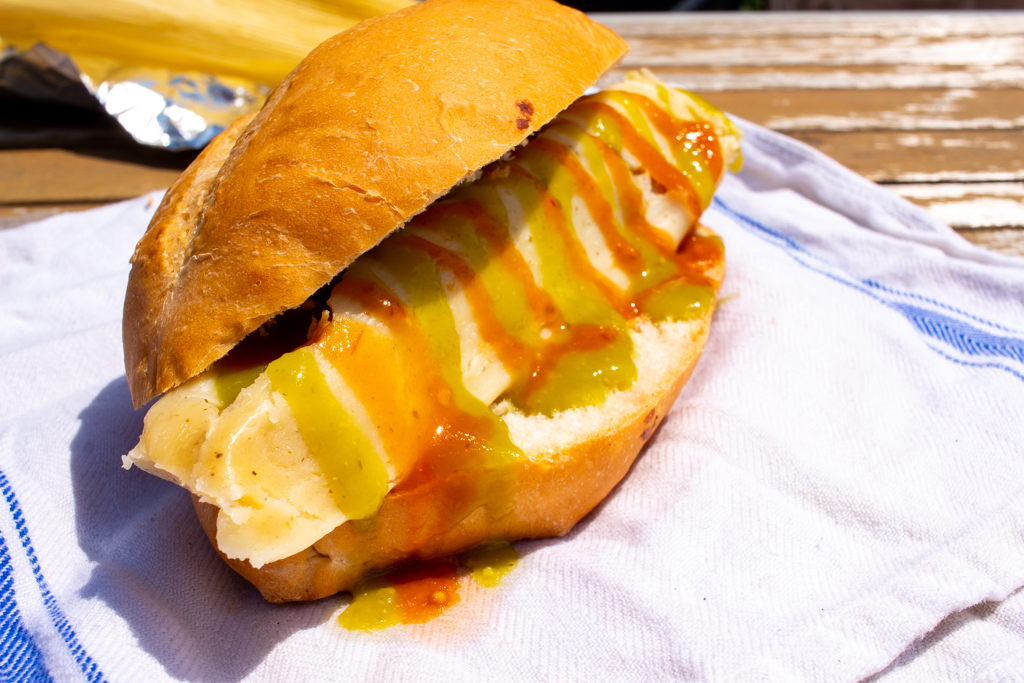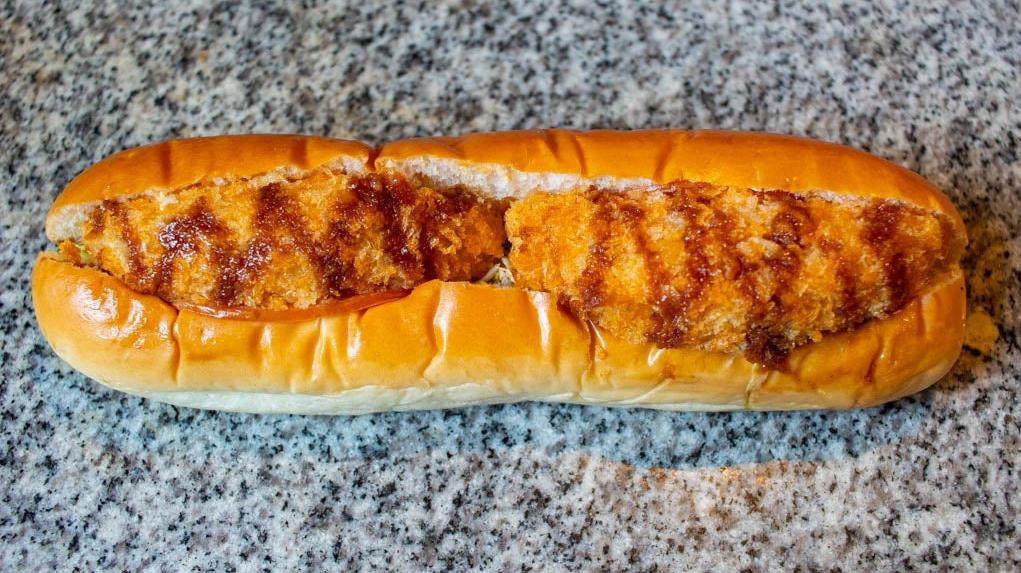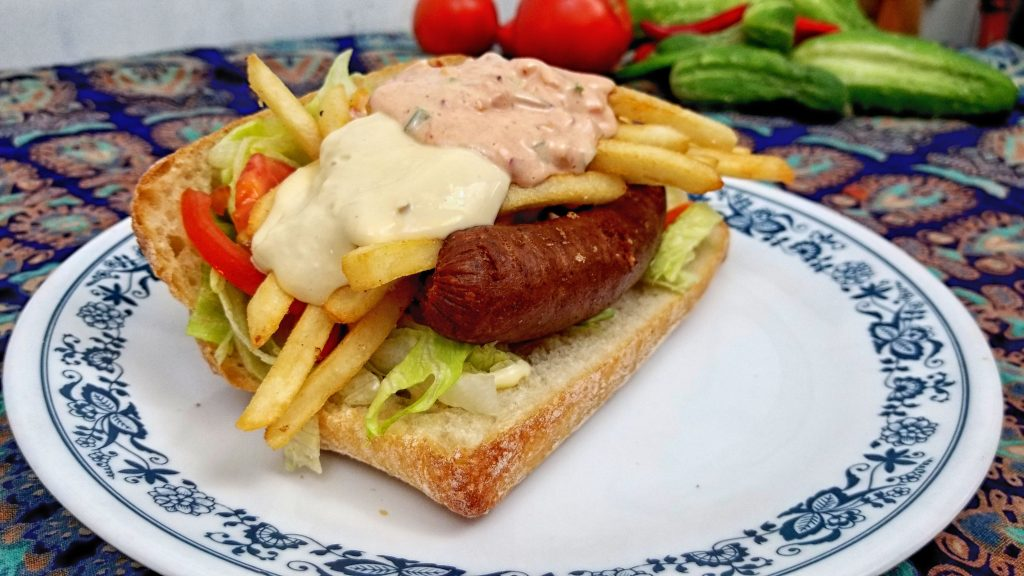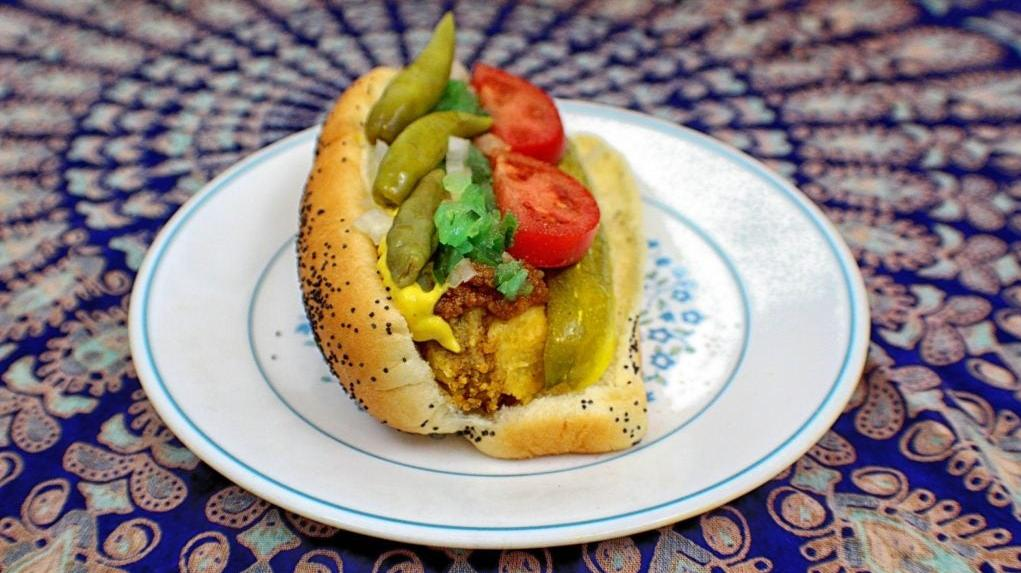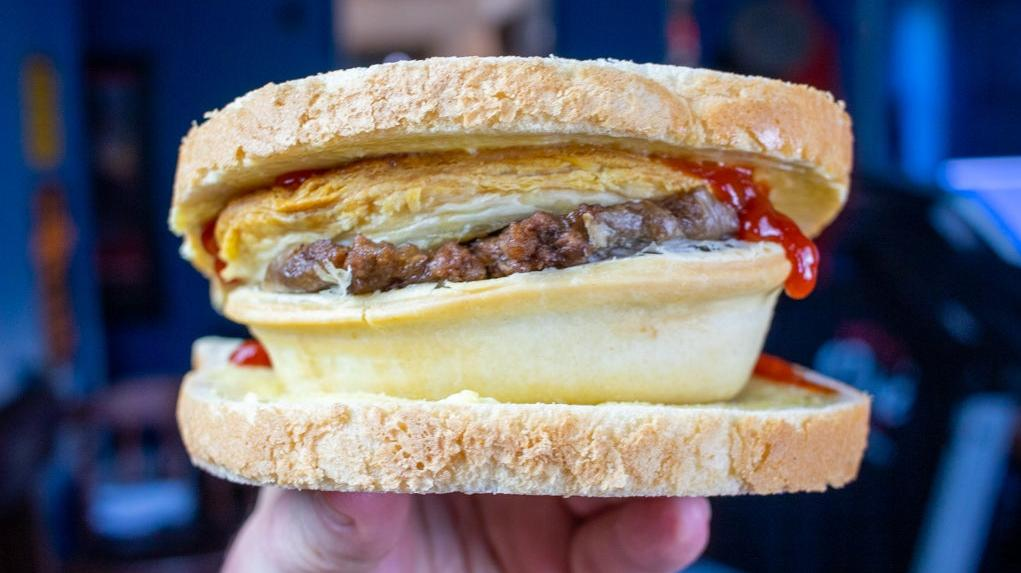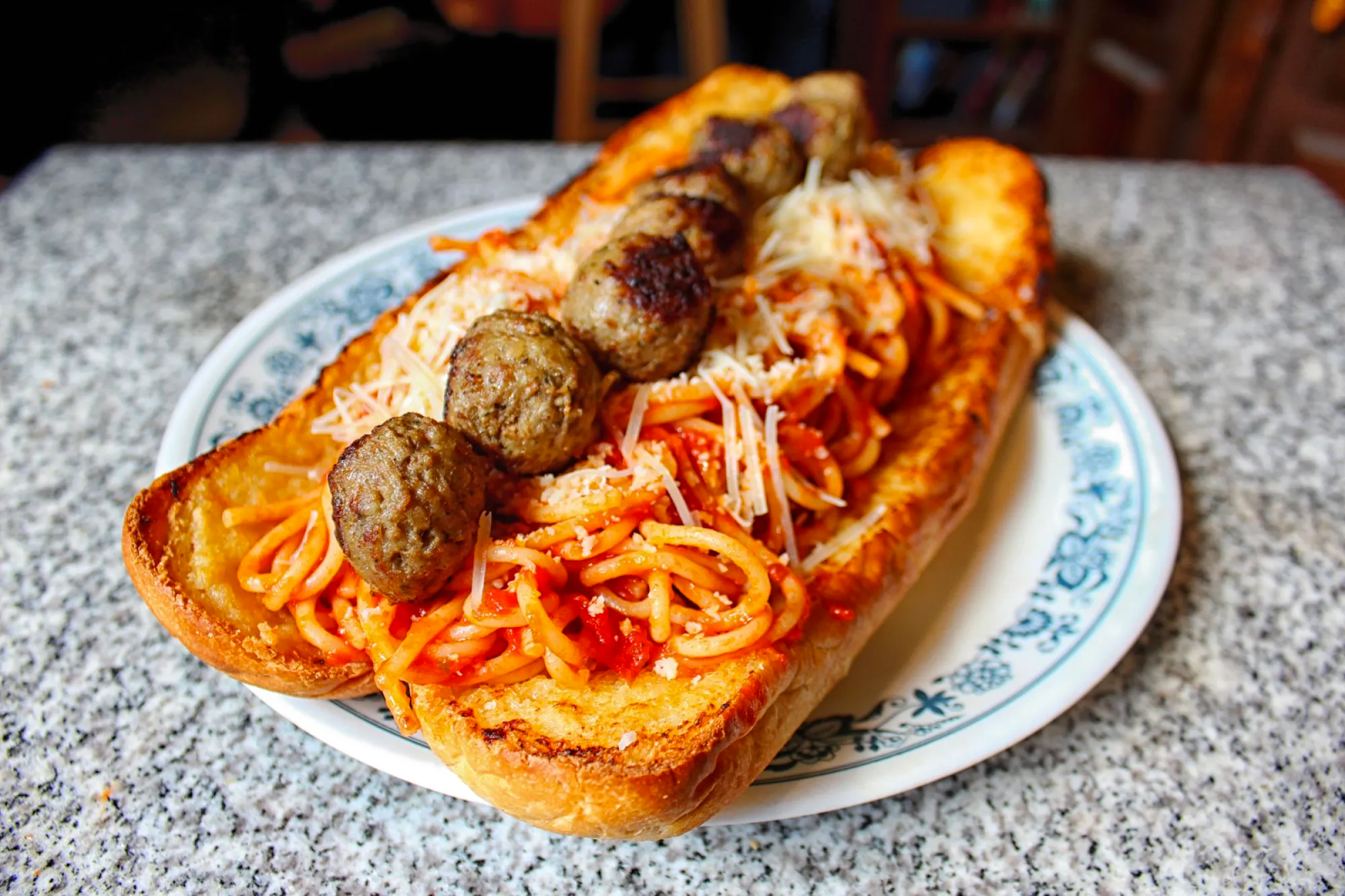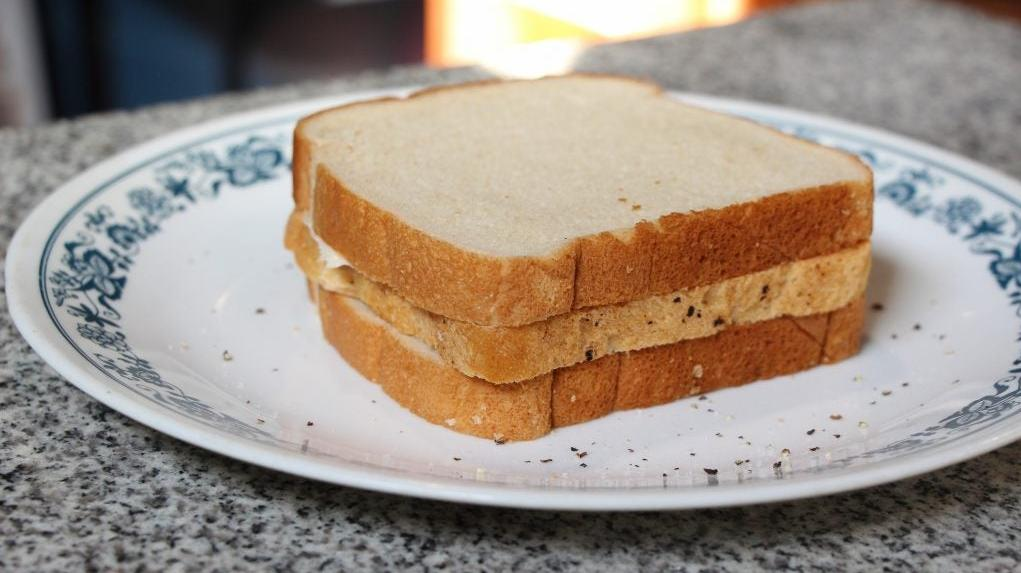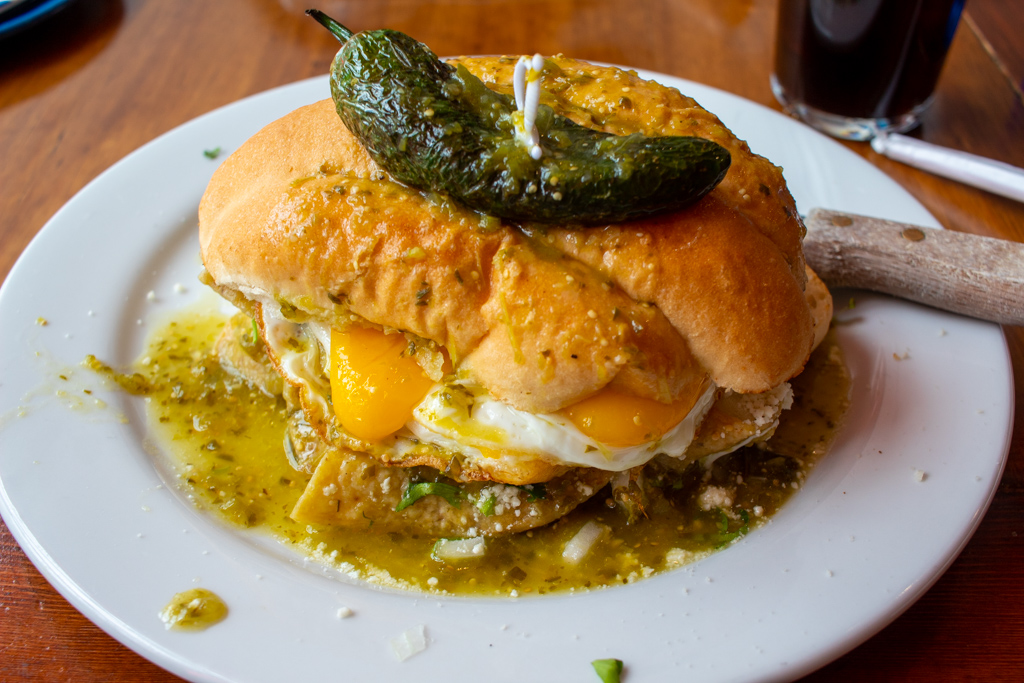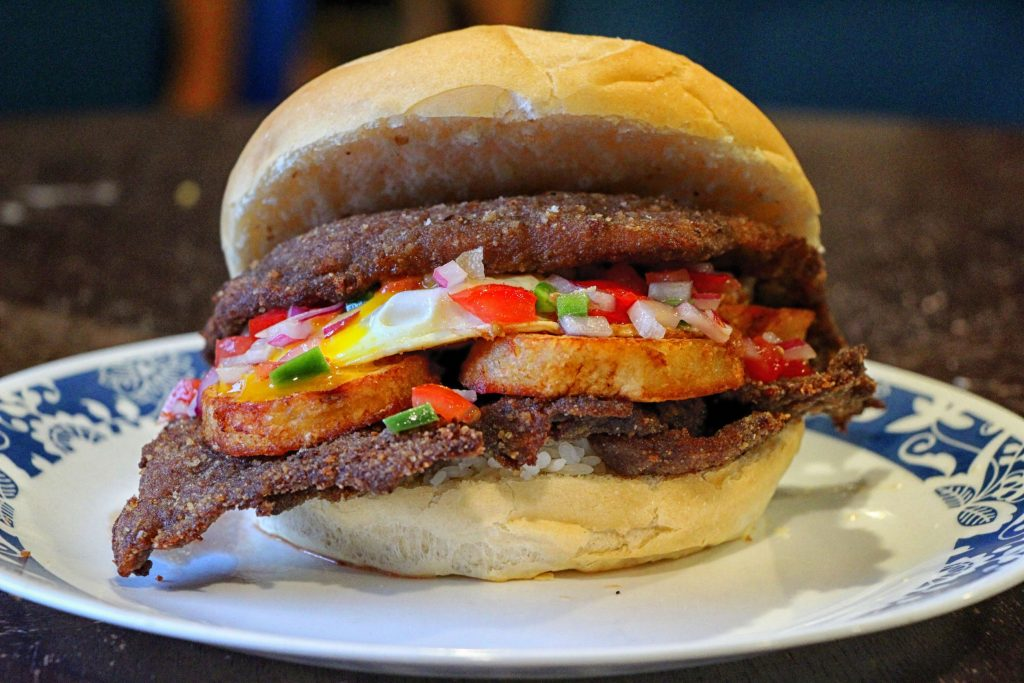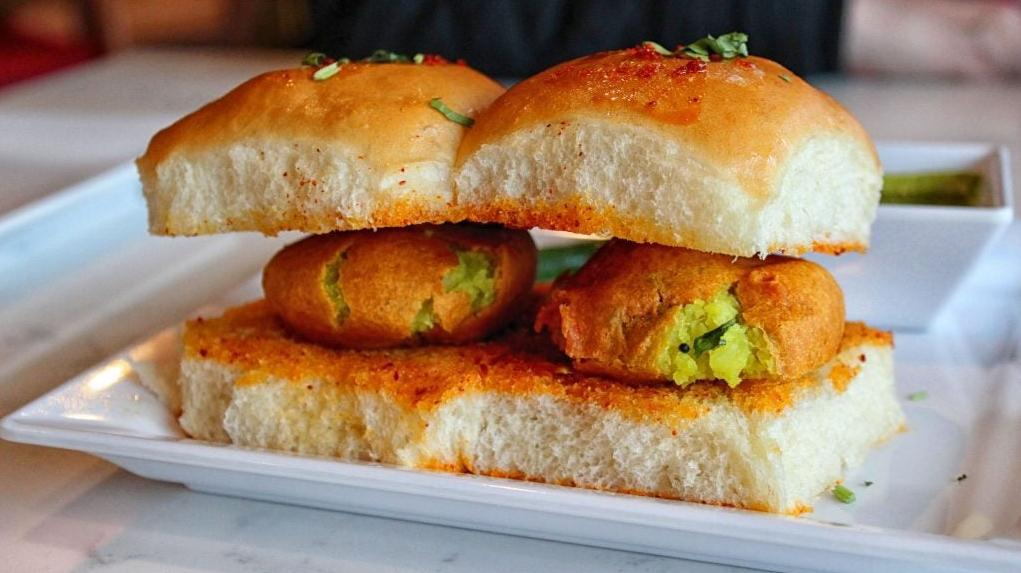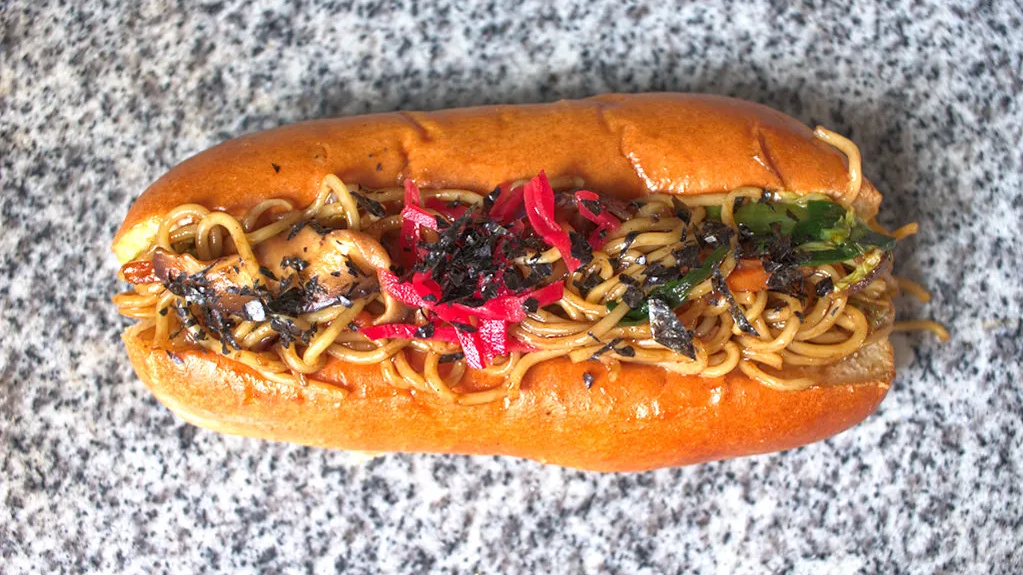17 Carb-On-Carb Sandwiches That Understand The Beauty Of Bread
These ultimate on-the-go comfort foods are double the starches and double the fun.
Portability is the goal of most street foods. Some are served in a sack, and others are served on a stick, but ones that stick with you—in the sense of remembering, of course, but also in the sense of sticking to your ribs—are the ones wrapped in bread to make a sandwich.
The warm, soft embrace of a pillowy roll, or a crusty baguette, or even a simple slice of white bread not only gives a stationary snack its walking papers, but also adds a new, starchy element to a dish, changing its essence, often for the better. But what if the original dish is itself already loaded with carbs? Then, my friend, you have entered the wide world of carb-on-carb sandwiches.
These may be more common than you think. From the simple to the sublime, starchy sandwiches are gobbled down by people all over the world. Potatoes and pasta and pastry (oh my!), rice and corn, even bread itself is not immune to being slapped between slices of bread to make a sandwich. If comfort food is defined as nostalgic, unchallenging food high in both calories and carbohydrates, then a carb-on-carb sandwich is the ultimate in comfort food on the go.
I've picked 17 examples to share with you, though that is far from the full extent. I'm not going to list every type of sandwich that might get a handful of shoestring potatoes thrown into it, nor every burrito or kebab wrap that features French fries. For the most part, these 17 sandwiches are centered around a carby component as the main ingredient, or at least as a signature flourish. Share your favorites with us in the comments, and let us know about any varieties you might have invented yourself.
Bocadillo de Tortilla
When the colonizing Spanish first encountered flatbreads made from nixtamalized corn in Mexico and Central America, they used the word "tortilla" to describe this staple of the indigenous diet, a word which translates literally into English as "small cake." In contemporary Spain, though, "tortilla" generally refers to a type of frittata made with multiple layers of soft, slow-cooked potatoes and sometimes onions enveloped in creamy cooked egg.
These potato omelets can be served at room temperature as a tapa, or small plate, but are often stuffed between two halves of a baguette to make a bocadillo de tortilla instead. Though ketchup, mayonnaise, or hot sauce are sometimes used to dress the bocadillo de tortilla, condiments are entirely optional in this warm hug of a sandwich.
Chip Butty
The king of carb-on-carb sandwiches is the chip butty, popular in the UK, Ireland, and the Antipodes. Less common in the US, it still manages to make the rounds on the internet every so often, such as when Burger King New Zealand introduced its own version in early 2020. British chips, cut substantially thicker than the "French fries" we're used to in the US, are fried up crisp and golden brown, then served piping hot between slices of buttered bread.
Most eaters will opt for ketchup, malt vinegar, or even HP Sauce in their chip butties, but for some true fans, hot chips and buttered bread are enough.
Chow Mein Sandwich
Native to Fall River in the South Shore area of Massachusetts–and not to be confused with the chop suey sandwiches from the North Shore–the chow mein sandwich is one of several street foods unique to the area. Featuring a bed of crisp chow mein noodles between slices of bread or halves of a hamburger bun, it can be ordered strained, where the chow mein gravy is added without the vegetables, or unstrained, for the full onion, celery, and sprouts experience. Some versions may include meat options such as chicken, beef, or shrimp as well.
Fall River is and has been the site of the Hoo-Mee Chow Mein factory since the 1920s, and this creative, cheap, tasty, and filling use of the product sustained many of the area's residents during the lean times of the Great Depression.
Crisp Sandwich
Many an American has added potato chips to a less-than-exciting sandwich to give it a salty, crunchy boost. In the UK and Ireland, often the potato chips themselves are the star ingredients of a sandwich. More than just the domain of the late-night post-binge snacker, there are shops in Dublin and Cornwall dedicated to these "crisp" sandwiches. Some fans swear that the less authentic the crisp's flavor is, the better it will taste in a sandwich. If you have an English or Irish shop near you, pick up some pickled onion or prawn cocktail flavored crisps and try them between slices of buttered white bread. Failing that, you can't go wrong with good old-fashioned salt & vinegar.
Dabeli
Biting into Dabeli, a snack roll from the Western Indian state of Gujarat, you might be hard-pressed to identify what you're tasting. This is in part because there are so many flavors in this sandwich that identifying individual ingredients is difficult.
The spread that comprises the core of this sandwich is a mildly sweet and highly aromatic potato masala. It is served in a pav—a small bread roll similar to a dinner roll or slider bun—with chutneys and some combination of diced onion, peanuts, grated coconut, chopped cilantro, pomegranate pips, crisply fried chickpea-based noodles called sev, and additional powdered spices. It would not be unheard of to laugh with joy upon first encountering this bewilderment of flavors; at the very least, I'd understand.
Gatsby
In the Cape Town area of South Africa, thick, floppy, vinegar-soaked slabs of fried potato called "slap chips" are stuffed into the massive Gatsby sandwiches served by many street food stands. The sandwiches can contain any number of different meats—steak, chicken, fish, curry, sausages, a local version of bologna called polony—and will also usually include lettuce, tomato, and achar, a type of chutney made from green mango.
The "Masala Steak" Gatsby, featuring strips of beef slowly stewed with browned onions in a curry sauce, is among Cape Town's favorite street foods. Those fried potatoes, though, steamed in a container briefly after frying to give them their signature floppy "slap" texture, are the defining feature of a Gatsby.
Guajolota
Sometimes called Torta de Tamal, the Guajolota is popular as an on-the-go breakfast among workers in Mexico City and is often served with a hot masa-based beverage called atole. It consists of a tamale stuffed into a bolillo roll and simply dressed, perhaps with some green and/or red salsa. It can be made with any kind of tamale, sweet or savory: pork, chicken, or cheese, either the standard cornhusk-wrapped or the massive banana-leaf-wrapped Oaxacan variety.
The name Guajolota is based on the Nahuatl word for turkey, though the reason for this nickname is unclear. This sandwich is filling and cheap while providing satisfying layers of flavor.
Korokke-Pan
Japanese Korokke-Pan, or "croquette bread," is made with deep-fried croquettes filled with a mashed potato mixture, shaped into thick cylinders, coated with panko bread crumbs, and fried until crisp, served in soft milk bread hot dog buns with mayonnaise, Worcestershire sauce, and thinly sliced tomato or cabbage.
These are often available pre-made and wrapped in plastic in the coolers of Japanese conbini alongside other sandwiches like egg salad or katsu sando. The panko breading manages to stay at least a little crisp, even wrapped in plastic, and the Worcestershire/mayonnaise combination is a great match for the mild but filling croquettes.
Mitraillette / Sandwich Américain
In Belgium and France, the thin, excellent local frites—that means "French fries" in American—are used in baguette-based sandwiches called, respectively, Mitraillette or Américain.
Mitraillette, which translates as "machine gun," consists of frites with a fried sausage or other meat, salad, and one or more of Belgium's many frite sauces: andalouse, remoulade, pirri pirri, curry ketchup, etc.
The Américain, on the other hand, consists of ground beef patties topped with fries, mayonnaise, tomato, lettuce, and perhaps some Gruyere cheese—as of course we Americans are wont to do. I kid, but the basics (fried meats and potatoes, covered in tangy sauces) are as American as it gets.
Mother-in-Law
The Mother-in-Law had a moment in the spotlight some years back when Anthony Bourdain sat at a rickety picnic table on Chicago's South Side with local food historian Peter Engler and ate Fat Johnnie's version of this heartburn-inducing and somewhat obscure local delicacy. There's a lot going on in a properly constructed Mother-in-Law, and it's worth trying if you find yourself at a hot dog stand that serves them.
It starts with Chicago-style tamales, factory-extruded cylinders of spiced ground beef and cornmeal descended from the Mississippi Delta–style tamales brought north by Black workers during the 20th century. These are placed in a hot dog bun, covered in chili, and as often as not topped with Chicago-style hot dog condiments: mustard, onion, pickle relish, a dill spear, tomato, celery salt, and sport peppers.
Pie Sandwich
The category of pie sandwiches is a culinary world unto itself.
In the north of England, hand pies or pasties full of meat, potatoes, and flour-thickened gravy are enclosed in soft, round bread rolls to make the pie barm, referred to in specific parts of Greater Manchester as the Wigan Kebab.
In Skopje, Macedonia, local bread rolls are filled with oily and crisp laminated pastry, like an unfilled burek, to make a local treat called Simit-poğaça.
In New Zealand, frozen hand pies filled with minced beef or lamb, microwaved at home or picked up warm from a convenience store, are slapped between buttered slices of bread with a squirt or two of ketchup and eaten as a late-night buffer against the next morning's inevitable hangover.
Meat pies, already a perfectly portable street food, are not made more portable by encasing them in bread. Still, it is an undeniably popular way of serving them all over the world.
Spaghetti sandwich
From the homemade foldovers made with leftover spaghetti and buttered bread, to the fancier piles of pasta and meatballs on garlic bread; from the crisp-fried antipodean jaffles or toasties filled with cheese and spaghetti bolognese, to the pastas of all shapes stuffed into hollowed-out torpedo rolls or bread cones gaining popularity in the Western United States—no matter how you serve them up, spaghetti sandwiches are a favorite way to reuse last night's dinner without need for plate or silverware, all over the English-speaking world.
It doesn't hurt that fork-twirling "spaghetiquette" is entirely unnecessary when downing one of these behemoths. My recommendation, however, is to clear time in your schedule for a post-prandial nap afterwards.
Toast Sandwich
The toast sandwich might be the pariah of this list. Introduced to the world by Mrs. Beeton's Book of Household Management published in 1861, the recipe calls for a thin slice of cold, toasted bread, seasoned with salt and pepper and tucked between two slices of buttered, untoasted bread. The recipe appears in a chapter called "Invalid Cookery" and was intended to be served to the sickly or infirm.
According to Mrs. Beeton, the toast sandwich "will be found very tempting to the appetite" of those who are unable to care for themselves, though she also admits the possibility of adding "very fine slices of cold meat." May I suggest adding turkey, bacon, mayo, tomato, and lettuce, and also toasting the outside slices of bread?
Torta de Chilaquiles
Chilaquiles are a masterpiece of poverty food, extending the life of a tortilla (which goes stale quickly) by cutting it up and deep-frying it into crisp totopos, then heating those totopos in salsa until they are soft in places yet still retain a bit of their former crispness in others. These chilaquiles form the basis of many a life-saving hangover breakfast, topped with fried eggs, cheese, avocado, more salsa, chorizo or chicken or cecina or just about any other standard taco filling.
The geniuses of Mexico City have done it again by slapping the chilaquiles into a telera roll for maximum portability. The torta de chilaquiles may require a fork and knife if you want to eat it without wearing half of it, but you'll find it worth the effort.
Trancapecho
Perched high up in an Andean basin, separated from more populous areas by the Cordillera Real range, lies the Bolivian city of Cochabamba. Here, one of the most popular local dishes is Silpancho, a very thin piece of steak Milanesa over a bed of rice with fried potatoes, fried eggs, and a salad of tomatoes, onions, and parsley.
In true street food fashion, the Trancapecho sandwich takes all those elements, plus local hot sauce llajua, and makes them portable by putting them between the sliced halves of a bread roll. This overachieving sandwich doubles down on the carb-on-carb format, including both potatoes and rice, and does it deliciously.
Vada Pav
A vada in South Asian cuisine is a type of snack where a featured ingredient such as a legume or vegetable is mashed into a spiced batter and deep-fried. Vada pav combines a number of very good ingredients into a whole that is greater than the sum of its parts: crisp batata vada made from cooked potatoes, chickpea flour, and spices formed into patties and fried until golden brown; soft pav rolls, cut in half and toasted or simply torn open by hand; and a spectacular dry, bright orange chutney made from coconut flakes, garlic, peanuts, sesame seeds, and plenty of powdered red chilies.
Other elements may be present as well, including sweet and sour tamarind chutney, green mint or coriander chutney, cilantro, and diced red onion, but the dry garlic chutney and the brightly herbal vada are the stars of this show.
Yakisoba-Pan
In Japan, Yakisoba is a type of noodle dish that is often made specifically to be used in sandwiches. Yakisoba are Chinese-style wheat noodles, stir-fried with onion, carrot, and other vegetables in a Worcestershire-based sauce, served in milk bread rolls like long, soft, narrow hot dog buns, topped with a sprinkling of crisp chopped nori and spicy, hot-pink pickled ginger sticks called beni shoga. Yes, people do eat Yakisoba by itself or as Omusoba, wrapped in a simple egg omelet–but wouldn't you rather have a Yakisoba-Pan sandwich?
